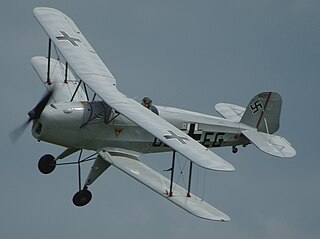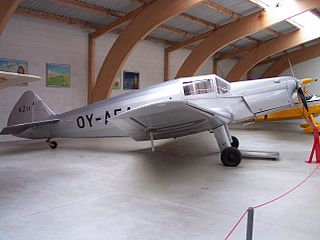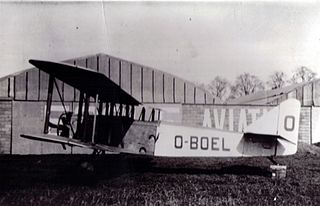
Auster Aircraft Limited was a British aircraft manufacturer from 1938 to 1961.

The de Havilland Canada DHC-1 Chipmunk is a tandem, two-seat, single-engined primary trainer aircraft designed and developed by Canadian aircraft manufacturer de Havilland Canada. It was developed shortly after the Second World War and sold in large numbers during the immediate post-war years, being typically employed as a replacement for the de Havilland Tiger Moth biplane.

The de Havilland DH.82 Tiger Moth is a 1930s British biplane designed by Geoffrey de Havilland and built by the de Havilland Aircraft Company. It was operated by the Royal Air Force (RAF) and other operators as a primary trainer aircraft. In addition to the type's principal use for ab initio training, the Second World War had RAF Tiger Moths operating in other capacities, including maritime surveillance and defensive anti-invasion preparations; some aircraft were even outfitted to function as armed light bombers.

The de Havilland Gipsy Major or Gipsy IIIA is a four-cylinder, air-cooled, inverted inline engine used in a variety of light aircraft produced in the 1930s, including the famous Tiger Moth biplane. Many Gipsy Major engines still power vintage aircraft types.

The Bücker Bü 131 Jungmann was a German 1930s basic training aircraft which was used by the Luftwaffe during World War II.

The de Havilland DH.60 Moth is a 1920s British two-seat touring and training aircraft that was developed into a series of aircraft by the de Havilland Aircraft Company.

The Auster J/1 Autocrat was a 1940s British single-engined three-seat high-wing touring monoplane built by Auster Aircraft Limited at Rearsby, Leicestershire.

The Auster J/5 Autocar was a late 1940s British single-engined four-seat high-wing touring monoplane built by Auster Aircraft Limited at Rearsby, Leicestershire.

The Auster J/5 Aiglet Trainer was a 1950s British single-engined four-seat high-wing training and touring monoplane built by Auster Aircraft Limited at Rearsby, Leicestershire.

The de Havilland Gipsy is a British air-cooled four-cylinder in-line aircraft engine designed by Frank Halford in 1927 to replace the ADC Cirrus in the de Havilland DH.60 Moth light biplane. Initially developed as an upright 5 litre capacity engine, later versions were designed to run inverted with increased capacity and power.

The Miles Hawk Major was a 1930s British two-seat light monoplane developed by Miles Aircraft from the Miles Hawk.

The Caudron C.280 Phalène ("Moth") was a civil utility aircraft built in France during the 1930s. It was a high-wing braced monoplane of conventional configuration with fixed tailskid undercarriage. The pilot and two-three passengers were accommodated within an enclosed cabin. The structure was wooden throughout, with the forward fuselage skinned with plywood, and the rest of the aircraft fabric-covered.

The Koolhoven F.K.46 was a 1930s Dutch training biplane designed and built by Koolhoven.

The SAI KZ II was a sport aircraft built in Denmark in 1937, produced in three major versions before and after the Second World War.

The Auster J series was a family of British light civil utility aircraft developed in the 1940s and 50s by Auster at Rearsby, Leicestershire.

The Stampe et Vertongen RSV.26/140, RSV.26/180, and RSV.26 Lynx were a family of training biplanes designed by Alfred Renard and built by Stampe et Vertongen in Belgium in the 1920s. They were produced as a response to a requirement by the Belgian Air Force, which became their biggest user, although private owners also bought a small number.

The Stampe et Vertongen RSV.26/100, RSV.18/100, RSV.26/18, and SV.18 were a family of two-seat touring aircraft designed by Alfred Renard and built by Stampe et Vertongen in Belgium in the 1920s and under license by Gates Aircraft in the United States as the Gates Convertiplane. Originally designed as a biplane, a monoplane version soon followed, and the aircraft was eventually marketed as convertible between the two configurations. Sometimes described as a lightened version of the RSV.26/140 military trainer, the RSV.26/100 was actually a fresh design.

The Stampe et Vertongen RSV.32 was a trainer aircraft produced in Belgium in the early 1920s. Designed originally for the Stampe et Vertongen flying school, the Belgian Air Force became a major operator of the type, where it became the first aircraft of entirely Belgian design and manufacture to enter service. Many others were purchased by flying clubs and private owners. No RSV.32 was in existence by the end of World War II.

The Stampe et Vertongen SV.5 Tornado was a military trainer aircraft designed and built in Belgium in the 1930s. It saw service with the Belgian Air Force and Latvian Air Force, and Latvian firm VEF purchased a production license, although it is uncertain whether it built any examples.

The Bernard 200 T was the first of a series of French light touring aircraft from the early 1930s. Single engined and seating three or four, they were high cantilever wing monoplanes. Four Bernard 200 T were built and subsequently modified into three further variants.


























